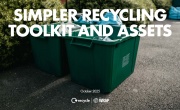UK’s waste infrastructure will be shaped by Brexit – Eunomia
The UK’s decision to leave the European Union has caused a huge amount of uncertainty in the UK’s long-term waste infrastructure, with the difference of having too much residual treatment capacity in 2020 or a continuous gap of supply resting on the result of protracted exit negotiations.
 These are some of the possible differences between a soft and a hard Brexit scenario considered by Eunomia Research & Consulting’s latest ‘Residual Waste Infrastructure Review’.
These are some of the possible differences between a soft and a hard Brexit scenario considered by Eunomia Research & Consulting’s latest ‘Residual Waste Infrastructure Review’.
The 11th issue of the consultancy’s twice-yearly review says that the development of new facilities has seen the UK’s capacity gap – the margin between the amount of residual waste being generated in the UK and the space in the nation’s treatment facilities to process it – close from 12.9 million tonnes in May to 10.2 million tonnes now.
With the gap closing, Eunomia also reports that the last six months have seen a number of energy-from-waste (EfW) developments reaching financial close, as the UK continues to invest in treatment for residual waste. The capacity to treat an extra 6.3 million tonnes per year is currently under construction or committed, while several new projects are applying for planning consent.
However, in attempting to look ahead and forecast future capacity trends, Eunomia says that the outcome of the government’s Brexit negotiations will shape the long-term nature of investments in residual waste infrastructure, as well as the level of waste that it needs to handle.
To this end, the review looks at potential scenarios that could come to pass under both a ‘hard’ and ‘soft’ Brexit.
Hard and soft Brexits
The report concludes that under a ‘high recycling’ scenario, which it says could result from a ‘soft’ Brexit, the UK’s supply of capacity would exceed the available quantity of residual waste in 2020/21, or 2023/24 if the export of refuse-derived fuel (RDF) is excluded from the analysis.
Under such a deal, the UK would maintain access to the European Single Market and stick to EU recycling targets (currently 50 per cent by 2020, but with a potential goal of 65 per cent by 2030, depending on the outcome of discussion around the EU’s Circular Economy Package).

Under what the report calls a ‘worst-case’ scenario, where the UK rejects the European targets and therefore sees no reduction in residual waste arisings, there would be a capacity shortfall of 1.7 million tonnes of residual waste – or 5.3 million tonnes if RDF exports are excluded. This is despite expected reductions in residual waste in Scotland and Wales, as England accounts for the vast majority of the UK’s waste.
The review concludes that such an outcome would create a difficult environment in which to plan for the right facilities to meet the UK’s needs, and the uncertainty could lead developers to consider additional investment in UK treatment capacity.
While the review notes that ‘the UK government might itself recognise the potential advantages of better resource management and itself pursue higher recycling rates, even under a hard Brexit scenario’, even with the European targets the UK’s recycling rate has been stifled by a lack of progress in England, with figures from the Department for Environment, Food & Rural Affairs (Defra) showing that the nationwide rate actually fell for the first time in 2015.
The report notes: ‘With Brexit unlikely to occur before 2019, it is likely that in the meantime the UK will continue its efforts to meet the 2020 target. Whether the UK adopts subsequent targets will depend on the eventual timetables for Brexit and for the CE Package, and the drafting of the Government’s proposed Great Repeal Act, which will see a snapshot of EU law transposed into UK legislation.’
Commenting on the review’s forecasts, Eunomia Managing Director Mike Brown said: “While we cannot yet say with confidence what form Brexit will take, a hard Brexit could mean taking a fresh look at our need for waste treatment infrastructure.
“However, there is a risk that during the current period of uncertainty, the UK may invest in facilities that could hinder our ability to achieve higher levels of recycling. A soft Brexit is likely to see us still aiming for 65 per cent by 2030. That’s still the direction of travel for the rest of Europe, and the result looks set to be a big increase in spare treatment capacity to be filled by RDF exports.”
Brexit could make RDF export financially unattractive
Regarding RDF, the review says that Brexit may make its export less financially attractive, but that the surplus treatment capacity amongst member states that the UK exports to, looked at in focus for the first time in Eunomia’s previous review in May, seems set to grow towards overcapacity by 2026.

In the May review, the ‘Northern Cluster’, the 11 countries in northern Europe actively involved in trading RDF and solid recovered fuel (SRF), was found to have a combined 104.2 million tonnes per year of ‘effective’ residual waste treatment capacity.
Treatment infrastructure throughout the cluster currently works to treat the 148.5 million tonnes of residual waste generated throughout the 11 nations. However, once these facilities are fully utilised, Eunomia warns that the capacity will exceed the 90.4 million tonnes of residual waste these nations are expected to produce in 2030.
Eunomia’s 11th ‘Residual Waste Infrastructure Review’ can be downloaded from the company’s website.









